About a year and a half ago, I wrote about 3 Trends Driving the Second Golden Age of Martech: Ecosystems, Experts, and (Citizen) Engineers. These are the big themes that I believe will shape the next decade of marketing technology:
- Ecosystems — instead of marketing cloud suites vs. best-of-breed point solutions, we will have the best of both: open platforms that serve as stable foundations, augmented by large ecosystems of specialized third-party apps that are more deeply integrated.
- Experts — the lines between software vendors and professional services firms will blur: software companies will offer more expert services; services firms will automate and bottle their expertise in code.
- (Citizen) Engineers — in a digital world where every company asymptotically becomes a “software business,” organizations will extend commercial platforms with customized customer experience apps and business process logic, many via “citizen developers.”
Earlier this month, when I published a model for the Spectrum of SaaS Platforms and Apps as a way to understand the continued expansion of the marketing technology landscape, I realized that it also explained the underlying structure of this Second Golden Age of Martech:
#1. Platform Ecosystems
It’s been the rise of open App Platforms — and to a certain degree, Service Platforms (e.g., Twilio, Stripe) and Cloud Platforms (e.g., AWS, Azure, Google Cloud) — that has changed the martech industry from a suite vs. best-of-breed dichotomy to interconnected platform ecosystems.
This transformation is effectively complete.
Think of any major marketing software company worth more than $1 billion today. Now, do a Google search for that company’s name with “app marketplace” appended. Like this:
I bet you’ll find their platform ecosystem as the top ranked search result.
As you then browse through those marketplaces you will find hundreds — thousands — of Specialist Apps, each promoting two things in their marketplace listing:
- The capabilities they bring to complement the platform.
- An assurance that they integrate with the platform.
I think we can safely check the box here: suites have given way to platform ecosystems.
#2. Blended Models of Software & Services
As you browse through all these different app marketplaces, you may notice something interesting about some of the providers listing apps. A number of them are also service providers within that same App Platform ecosystem.
For instance, in HubSpot’s ecosystem, you will find a number companies who are both App Partners and Solutions Partners, such as Bayard Bradford, Blue Green Brands, Inbound Labs, LyntonWeb, MakeWebBetter, etc. They provide services, ranging from marketing agency work to custom website development. Yet they also have created stand-alone apps that they have packaged up and promote in HubSpot’s app marketplace.
Most of the time, the apps they built are right in the wheelhouse of the services they provide. For example, Blue Green created Blue Green Analytics — which visualizes customer journey analytics — based on their years of experience doing path-based conversion optimization for major brands.
These apps may be stand-alone businesses, but more often, they’re entwined with the services the company offers. They help with client acquisition, retention, and success. The combination of software and services helps differentiate the company, amplify its discoverability, and build its reputation within the ecosystem.
It would be significantly harder to build these kinds of businesses in a world of closed suites or a free-for-all of disconnected point solutions without a common platform. The former would simply preclude any Specialist Apps that would extend or tailor its capabilities; the latter would make it difficult to gain critical mass of reputation within a community, as each point solution product would be isolated within its own silo.
I expect that App Platforms will produce a lot more of these blended software and services businesses. We’re still early in this evolution, but there are enough examples to prove that the hypothesis holds water.
Partial check of this box for the Second Golden Age.
#3. Custom Apps & Ops on a Common Core
Yet the number of Specialist Apps pales in comparison to the number of Custom Apps built to serve a specific need for one particular business. Between Cloud Platforms, Service Platforms, and App Platforms, it has never been easier for a company to write their own software by standing on the shoulders of giants.
What’s now different with the Second Golden Age of Martech is that instead of a build vs. buy dichotomy, companies can start with a commercial platform and then simply tailor their own custom apps & ops on a common core.
This approach is much better because:
- They don’t have to waste effort reinventing the wheel of commoditized capabilities.
- The Custom Apps they build on these platform foundations, particularly App Platform foundations, inherit the benefit of integrating with the rest of that platform’s ecosystem. That includes both packaged Specialist Apps and other Custom Apps.
Most of the App Platforms don’t publish stats on the number of developers working in their ecosystems. However, extrapolating from some points on the curve — e.g., Twilio reported having 5 million developers a year ago — you can get a directional sense of how the number of developers working on Custom Apps is easily an order of magnitude more than those building packaged Specialist Apps. An iceberg has 90% of its mass below the visible waterline.
I believe we can partially check this box too, pending more developer stats being released.
Seeing how the Spectrum of SaaS Platforms and Apps supports these three trends reinforces the validity of both models in my mind. Granted, they both come from the same person, so that alignment should be taken with that caveat. You could argue this is just a tautology. But I encourage you to think through these concepts independently and compare them with the empirical evidence you see in your work.
In spite of the craziness of the current time, these larger trends are still moving forward. To paraphrase Yoda, “Begun, the Second Golden Age of Martech has.”
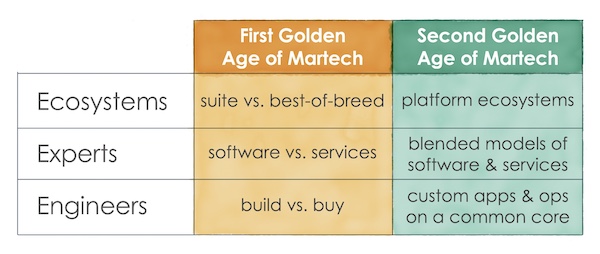
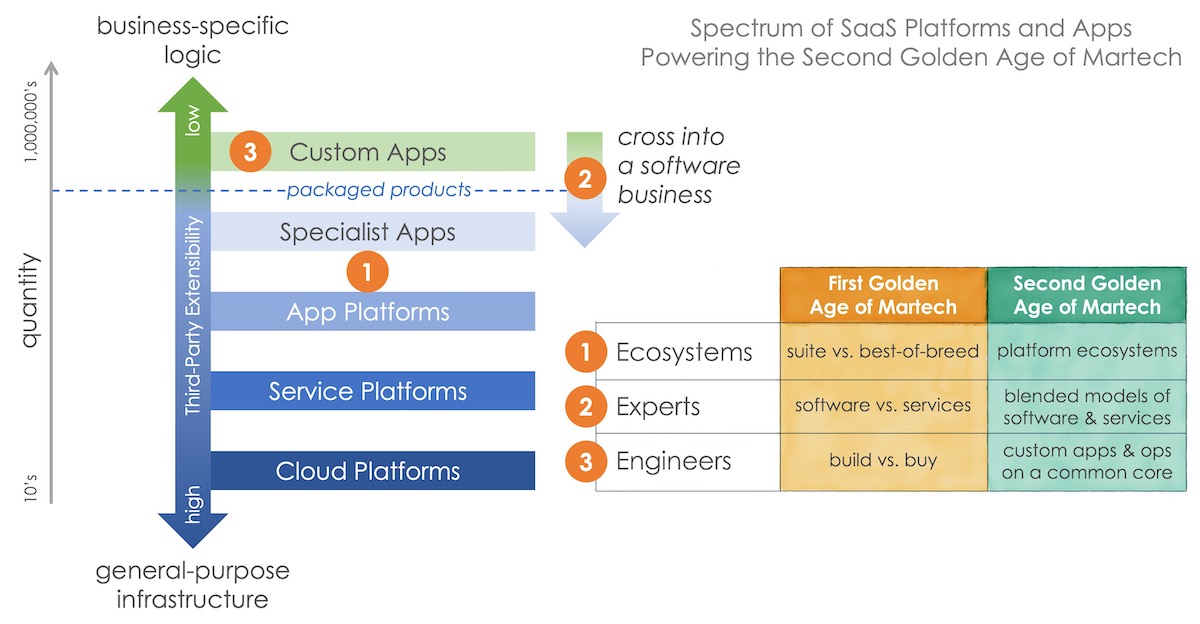

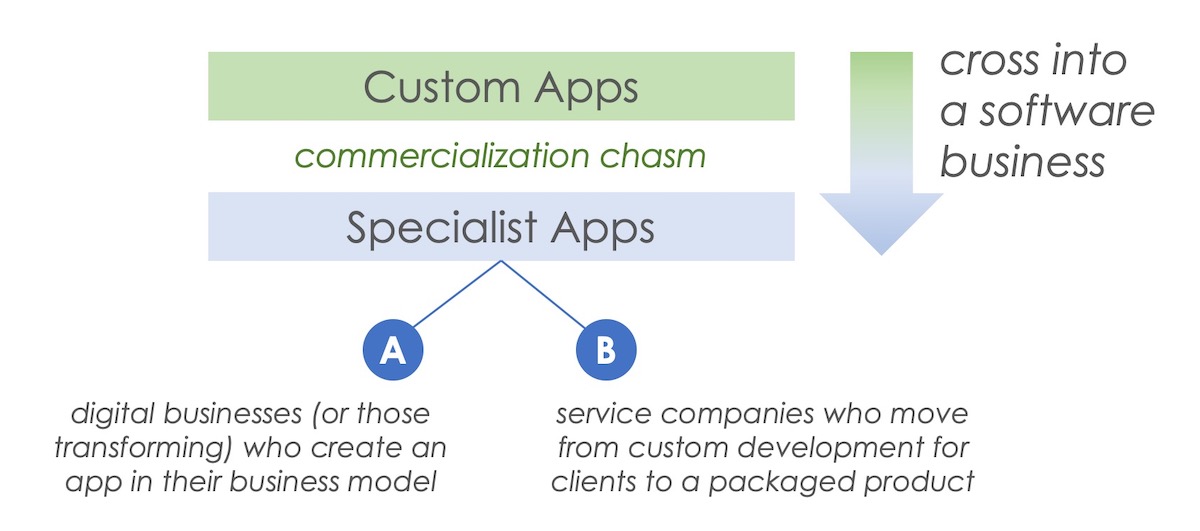
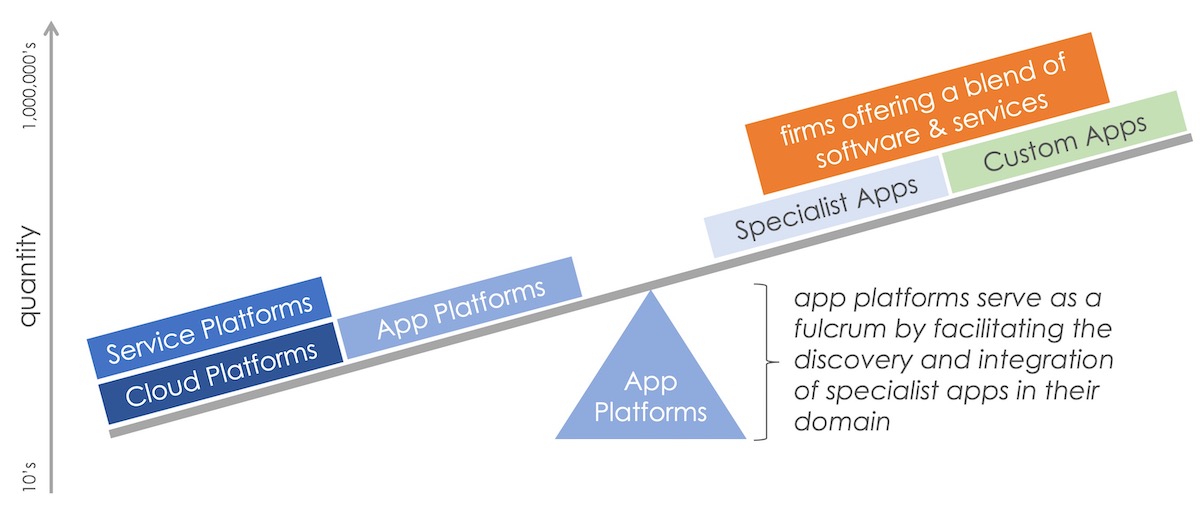
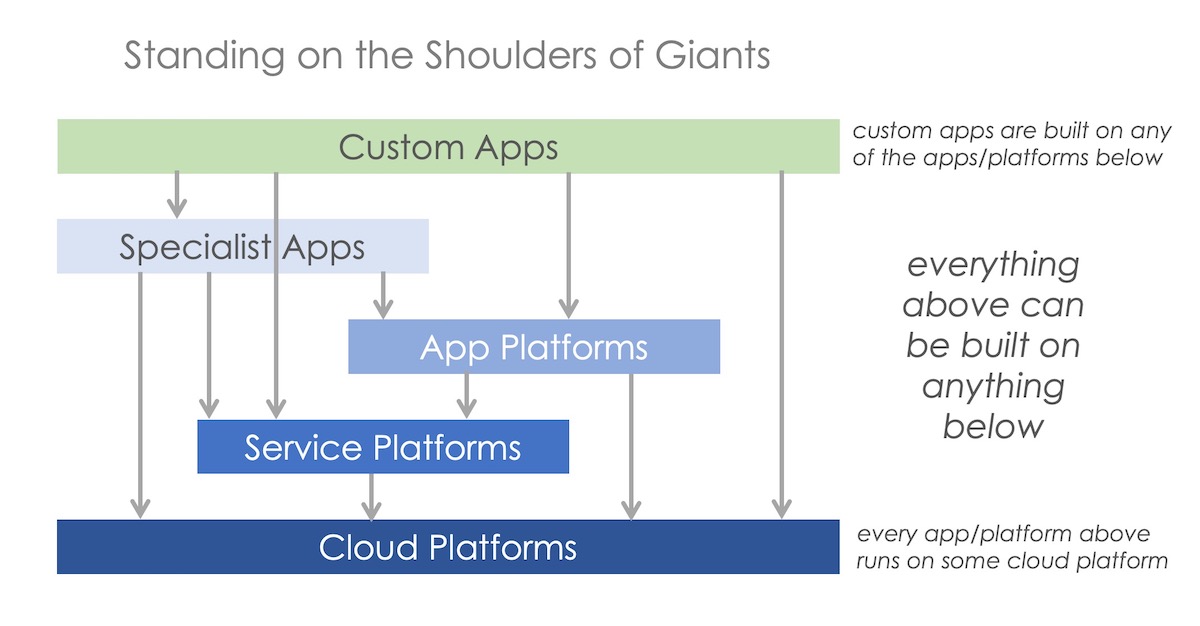



Thank you for including Bayard Bradford in the Expert category in your excellent analysis. As a HubSpot solutions partner, our client outcomes depend on delivering a blend of software and services.
I would add that our strategy in delivering this blend is to make the HubSpot platform easier to switch to and adopt. Towards this end, we built Datawarehouse.io, a rapid deployment integration solution that is optimized specifically for the HubSpot platform. We did this to simplify integrating SQL Server databases with Hubspot and keeping them in sync. Our middle market industrial client base makes heavy use of the Microsoft environment and Azure SQL Server applications are growing rapidly. The net effect is to facilitate incorporating HubSpot into their existing Microsoft environment while migrating them to HubSpot’s powerful tools for business growth. Experience has taught us that the martech stack must flex and fit with existing business applications — not the other way around.